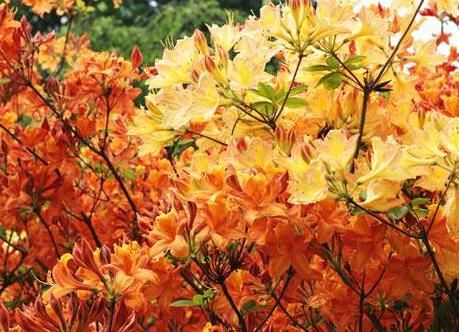Azaleas & Rhododendrons
Here at Gertens, we have some great tips on how to plant and care for rhododendrons and azaleas. Follow our instructions, and you’ll grow healthy plants—guaranteed!
 |
| Both Rhododendrons and Azaleas bloom in early spring! |
Rhododendrons are usually evergreen, meaning they retain their leaves throughout the winter, where azaleas are in the genus rhododendron but they are deciduous. They both bloom in early spring and are a vibrant display for that time of year.
Azaleas
Bloom in spring in a variety of colors. The University of Minnesota developed the lights series for our climate. They are dependable bloomers and have a good fall color. The Weston Hybrid azaleas bloom in June and July and have a great fall color. They are a thicker plant, but need winter protection. All of these azaleas come in yellow, pink, white, red, orange, and purple.
Care
Azaleas enjoy full sun or partial sun. They do not have the winter sun issues that the rhododendrons do. They also enjoy an acidic environment and peat moss should be added at planting.
Fertilizer
Fertilizer in spring like the rhododendrons with an acidic fertilizer.
Insects and Disease
They have the same possible problems as rhododendrons.
Pruning
Prune the same as rhododendrons.
Rhododendron:
Rhododendrons come in small leafed varieties and large leafed varieties. The small leafed varieties have a greater tolerance to the winter sun and are more winter hardy than large leafed varieties. They flower in pastels of pinks and purples for the small-leafed varieties, whereas the large-leafed varieties come in white, red, and pink. They keep their leaves all winter which turn a deep purple in the fall. (PJM Rhododendron pictured above).
Care
Rhododendrons are sensitive to extreme heat; therefore they would not do well on the south side up against a building. They are sensitive to winter sun as well as winter winds therefore it is best to place them on an east side. They do enjoy well-drained soil and need consistent water as their roots are so close to the surface and can dry out faster.
Fertilizer
At planting it is best to add organic matter such as compost and peat moss, which will raise the soil pH slightly. They enjoy an acidic soil so, fertilize with an acidic fertilizer, such as ammonium sulfate, in spring or early summer. A pH of 4.0-5.5 is optimum for growth.
Insects and Disease
They can get root rot fungus if the soil is not well drained. They can also get powdery mildew if the summer is hot and humid, any general fungicide can be used. If leaves are turning chlorotic, the soil may be too alkaline and further acidification is needed. They do not have many insects. Rabbits and other rodents tend to feed on these plants. It is best to protect them with a deterrent.
Pruning
Prune in the spring immediately after they are done flowering. Do not prune any more than 1/3 of the plant’s height.

